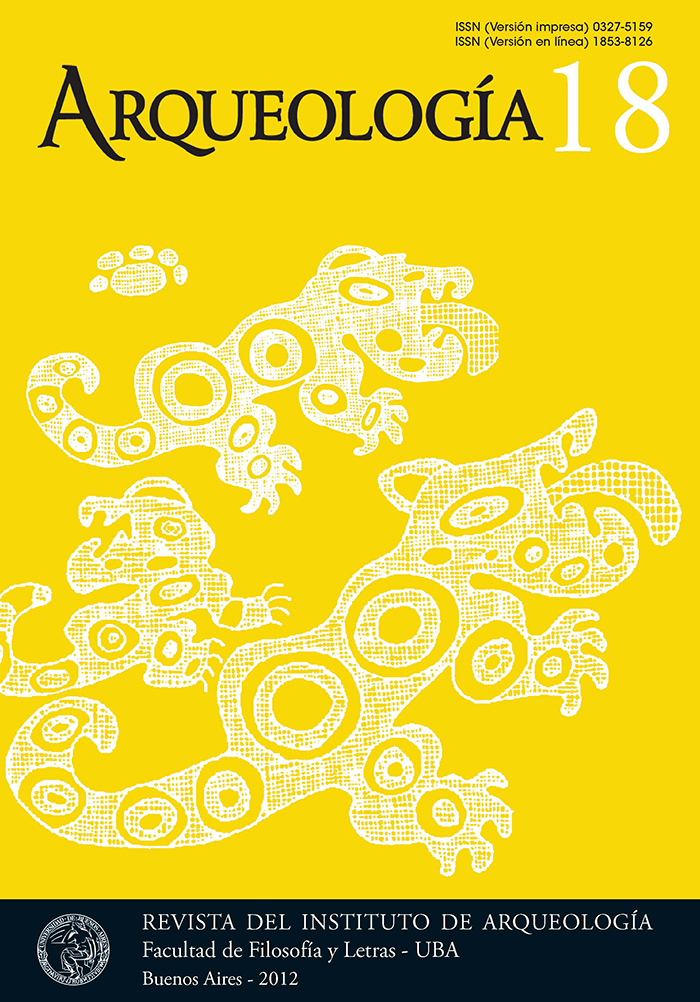Estado actual de las investigaciones arqueológicas en la localidad Nutria Mansa. Nuevos aportes de los artefactos picados y/o abradidos
Palabras clave:
cazadores-recolectores, costa atlántica pampeana, Holoceno tardío, tecnología lítica, análisis faunístico
Resumen
Las investigaciones desarrolladas en la localidad arqueológica Nutria Mansa (partidos de General Alvarado y Lobería) han aportado importante información para el estudio de los cazadores-recolectores pampeanos que ocuparon el litoral marítimo bonaerense a finales del Holoceno. En este trabajo se presenta el estado actual de los estudios sobre la base de nuevos resultados del análisis faunístico (determinaciones taxonómicas y anatómicas, cuantificación zooarqueológica) y lítico (pigmentos minerales, remontajes, identificación de materias primas). Asimismo, se estudian con especial énfasis los artefactos picados y/o abradidos de la localidad. Este conjunto artefactual incluye instrumentos de molienda, bolas de boleadoras, percutores, yunques, abradidores-pulidores y artefactos compuestos. Se utilizaron rocas de procedencia principalmente local, y otras de fuentes inmediatamente disponibles u obtenidas a larga distancia. La mayor parte de los instrumentos de molienda y todas las bolas de boleadoras fueron manufacturadas, mientras que en los percutores fue frecuente aprovechar formas-base naturales sin modificaciones previas al uso. Se destaca la alta presencia de múltiples caras activas en cada pieza en la mayoría del conjunto picado y/o abradido. Se identificaron diferentes estrategias de mantenimiento y administración del desgaste, así como también evidencias del reciclaje de artefactos. El análisis de las diferentes evidencias arqueo-lógicas de la localidad Nutria Mansa permite abordar las múltiples actividades desarrolladas en campamentos de cazadores-recolectores asentados en las cercanías al litoral marítimo bonaerense.Descargas
La descarga de datos todavía no está disponible.
Cómo citar
Bonomo, M., & Matarrese, A. (1). Estado actual de las investigaciones arqueológicas en la localidad Nutria Mansa. Nuevos aportes de los artefactos picados y/o abradidos. Arqueología, 18, 153-180. https://doi.org/10.34096/arqueologia.t18.n0.1812
Número
Sección
Artículos
Los autores/as que publiquen en esta revista aceptan las siguientes condiciones:
- Los autores/as conservan los derechos de autor y ceden a la revista el derecho de la primera publicación, con el trabajo registrado mediante Licencia Creative Commons 4.0 Internacional (CC-BY-NC-SA), que permite a terceros utilizar lo publicado siempre que mencionen la autoría del trabajo y a la primera publicación en esta revista.
- Los autores/as pueden realizar otros acuerdos contractuales independientes y adicionales para la distribución no exclusiva de la versión del artículo publicado en esta revista (p.e. incluirlo en un repositorio institucional o publicarlo en un libro) siempre que indiquen claramente que el trabajo se publicó por primera vez en esta revista.
- Se permite y recomienda a los autores/as a publicar su trabajo en Internet (p.e. en sus sitios web personales o en depósitos institucionales), tanto antes como después de su publicación en esta revista, siempre y cuando proporcionen información bibliográfica que acredite, si procede, su publicación en ella. De esta manera, pueden favorecerse intercambios productivos y a una mayor y más rápida difusión del trabajo publicado (vea The Effect of Open Access).



.png)

(1)13.png)






1.jpg)
1.png)
1.jpg)


13.png)
1.png)


(1)1.png)









